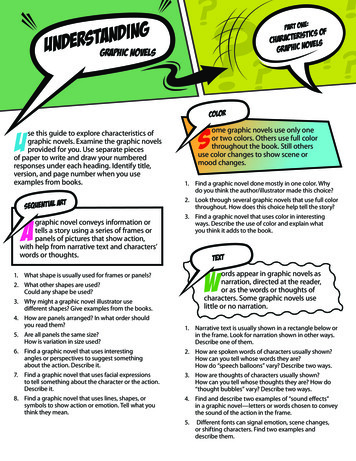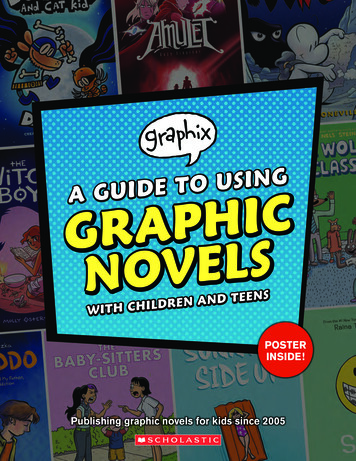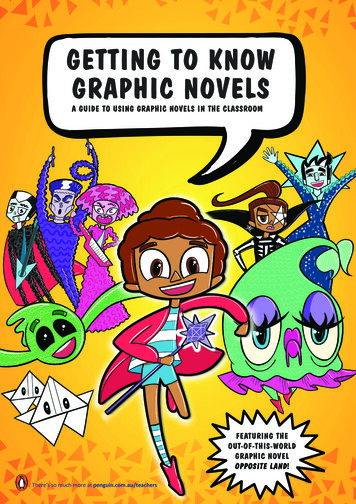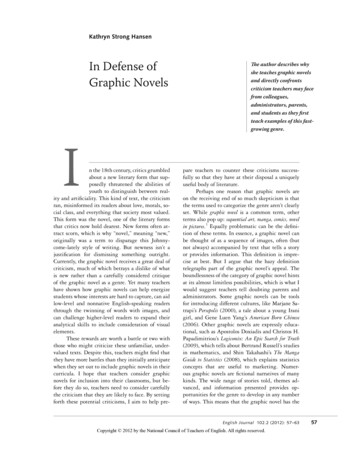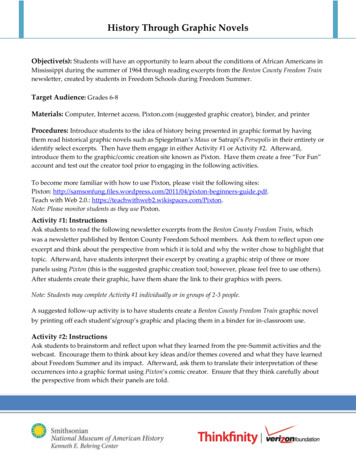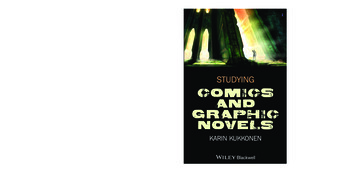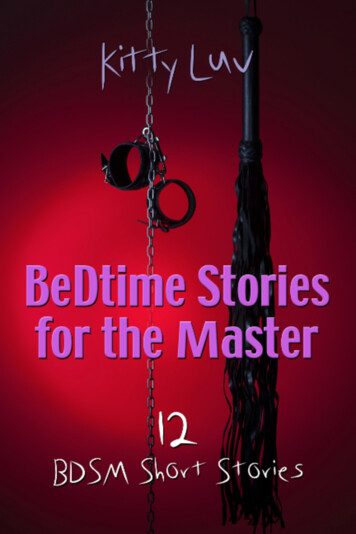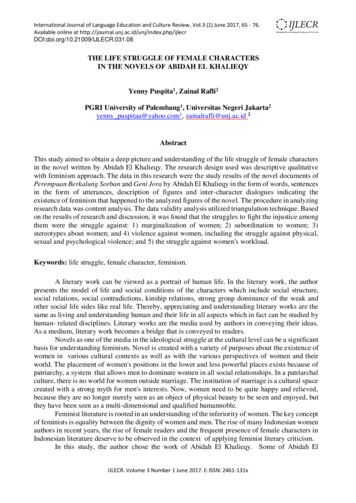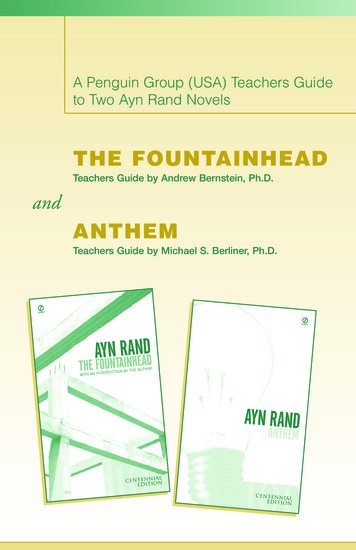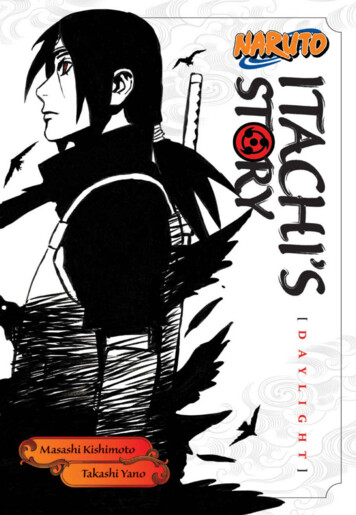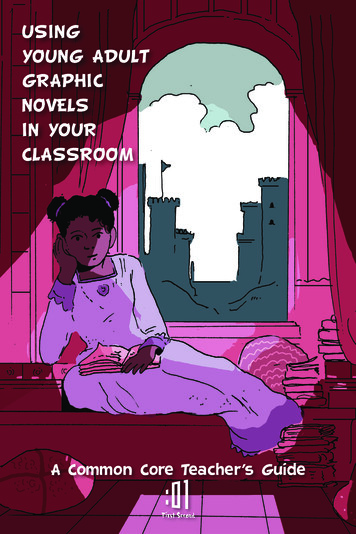
Transcription
USINGYOUNG ADULTGRAPHICNOVELSIN YOURCLASSROOMA Common Core Teacher’s Guide
Making the Case for Graphic Novels in the ClassroomThe fact is that your students are probably already reading graphic novels and have not toldyou because they worry, as you might, that sequential art is not “real” reading. Nothing couldbe further from the truth.Educators have published a number of studies in peer-reviewed scholarly journals whichoffer specific data to prove that students benefit from the use of comics in their educational journey. Two such teachers are Dr. Nancy Frey and Dr. Douglas Fisher, who noticed thattheir students were reading manga, a Japanese comic format. When they investigated thesebook, their eyes were opened to a whole new world of reading that was already embraced bytheir pupils. In their article “Using Graphic Novels, Anime, and the Internet in an Urban HighSchool,” they write:We now realize the power they [graphic novels] have for engaging students in authenticwriting. These forms of popular culture provided a visual vocabulary of sorts for scaffolding writing techniques, particularly dialogue, tone, and mood.They saw that this type of storytelling had the power to help teach and reinforce the skillsneeded for the success of their students in the literacy-centered classroom. We invite you todo the same and to pass this knowledge on to your department chairs and administrators. Ifyou are ready to bring these wonderful texts to your classroom, remember that you are notalone. The scholarship and the hundreds of teachers nationwide who have already effectivelyimplemented graphic novels in their own classrooms will have your back.The Range of Graphic NovelsWhether you’ve taught a graphic novel or not, there’s no need to worry. Here are five insightsto help you either start teaching graphic novels or jump-start your own preexisting lessonideas . . .1. Art Analysis—The artwork and images in a graphic novel tell the story in a way that issimilar to the function of text in traditional novels, and it is essential that readers know topay equal attention to the art and images.2. Text Analysis—The text in a graphic novel is like the text in a traditional novel and workswith the art and images to tell the story. The text and the artwork are co-stars of the story.As in a traditional prose novel, it is important for students to understand the text in agraphic novel. Graphic novels rely on all of the same textual features found in traditionalprose novels, like similes and metaphors, grammar and mechanics, tone and style, point ofview and narration, and so forth.3. Elements of Story—Graphic novels adopt all of the elements of story found in traditionalliterary novels, including but not limited to deep explorations of character, setting, theme,and plot. The key is for readers to look for each element of story in both the words and theartwork in graphic novels.4. Familiar Genres—Graphic novels can be found in all the genres typically found in traditional literature. History, mystery, biography and autobiography, fantasy, science fiction,adventure, and coming-of-age are just some of the typical graphic novel genres.1
5. Pair with Traditional Literature—Because graphic novels operate on a literary level, theyare easily paired with traditional literature, especially when the themes or plots of the twotexts are similar.With these five insights in mind, let’s discuss how First Second’s young adult graphic novelscan offer educators an extremely wide range of teaching potential, from categorical labelsand genres that are familiar (like mystery, science fiction, historical fiction and nonfiction, biography and autobiography, etc.) to content area relevancy and loaded lesson plan potential.First Second graphic novels provide an ever-growing spectrum of high-quality, literary-leveltexts. For your teaching convenience, this teacher’s guide presents recommendations andcontent for individual titles.Basic Graphic Novel TerminologyPANELSThe visual or visually implied boundaries that contain one or more of the elements of story(characterization, setting, plot, theme), panels are traditionally known to appear in squareand rectangular formats but are in no way limited to those shapes. Panels can sometimes bean entire page, with the boundary and formatting limits being the literal page itself; they canalso take many other types of shapes and sizes depending on the goal of the story at thatmoment. For instance, if a character is having a daydream the panel outline might be smoothand wavelike to intimate the free flow of thoughts and ideas that are typical of a dream.Although they can take any shape (and readers should be prepared to identify those variousshapes), panels are ultimately and simply understood as visual containers of an element orelements of a story. Gene Luen YangGUTTERSIn the space between the panels, the reader’s imagination takes over and connects twopanels (and their elements of story) in order to create a flowing and seamless storyline (seeScott McCloud’s Making Comics for further explanation). When teaching about and visualizing the potential of the gutter in a graphic novel, ask students to imagine individual pieces,finding the right matches and the connection that occurs when the pieces are placed together. The gutters in a graphic novel help connect puzzle pieces in order to build and ultimatelyreveal the entire picture.2
Nate PowellBALLOONSBalloons usually contain the print or word-based elements of story. Whether spoken ornarrated words, print images or sound effects, balloons convey the literary elements of storythat progress the plot and enhance a reader’s understanding of what is going on in eachpanel as well as through each gutter transitional connection. Just like panels, balloons canbe contained by visual or implied boundary indicators. Mike CavallaroAmerican Born Chineseby Gene Luen YangAbout the BookJin Wang starts at a new school where he’s the only Chinese American student. When a boyfrom Taiwan joins his class, Jin doesn’t want to be associated with an F.O.B. like him. Jin justwants to be an all-American boy, because he’s in love with an all-American girl. Danny isan all-American boy: great at basketball, popular with the girls. But his obnoxious Chinesecousin Chin-Kee’s annual visit is such a disaster that it ruins Danny’s reputation at school,leaving him with no choice but to transfer to another school where he can start all over again.The Monkey King has lived for thousands of years and mastered the arts of kung fu and theheavenly disciplines. He’s ready to join the ranks of the immortal gods in heaven, but there’sno place in heaven for a monkey. Each of these characters cannot help himself on his own,but how can they possibly help each other? They’re going to have to find a way—if they wantfix the disasters their lives have become.3
Discussion Questions1. What role does foreshadowing play in the book? Where does the text hint at how thesestories will be resolved?2. How does prejudice factor into this story? Pull examples from the text to illustrate yourconclusions.3. How do the main characters (Monkey King, Jin/Danny, Wei-Chen) develop and grow overthe course of the book? What lesson does each of them learn?4. Consider how the stories all converge at the end of the book. Were you expecting the ending you got? What surprised you?Brief Teaching Recommendationsfor Educators and Readers1. Create a carousel activity where each stationcontains a large sheet of poster-size paperaffixed to a different wall in the classroom. Putthe name of a character on each poster (MonkeyKing, Jin/Danny, Wei-Chan, Chin-Kee, Suzy, WongLai-Tsao). Divide the class into one group perposter and have each group write down questions, observations, and opinions of the character on their poster. After five to seven minutes,have the groups rotate to the next poster. Repeatuntil every group has seen and commented onevery the poster. Review their comments.Ages 12–18 PB 9780312384487 PB 9781596431522 HC 97815964337312. Assign students or pairs of students one of theChinese gods mentioned in the story. Have themresearch the gods and present their findings tothe class, including their opinion of how wellGene Luen Yang represents them in his book.3. Have students look up the theological and mythological legends of their own history. Doestheir understanding of the god or gods that they or their ancestors worshipped changetheir perception of their cultures?Suggested Common Core Standards AlignmentBecause they encompass the ultimate goal for reading literature in grades 9 through 12, the most relevant Common CoreStandards for 11th- and 12th-grade literature are listed here.CCSS.RL.11-12.1 Cite strong and thorough textual evidence to support analysis of what the text says explicitly as well as inferencesdrawn from the text, including determining where the text leaves matters uncertain.CCSS.RL.11-12.2 Determine two or more themes or central ideas of a text and analyze their development over the course of the text,including how they interact and build on one another to produce a complex account; provide an objective summary of the text.CCSS.RL.11-12.3 Analyze the impact of the author’s choices regarding how to develop and relate elements of a story or drama.CCSS.RL.11-12.5 Analyze how an author’s choices concerning how to structure specific parts of a text contribute to its overall structure and meaning as well as its aesthetic impact.4
CCSS.RL.11-12.6 Analyze a case in which grasping point of view requires distinguishing what is directly stated in a text from what isreally meant.CCSS.RH.11-12.1 Cite specific textual evidence to support analysis of primary and secondary sources, connecting insights gainedfrom specific details to an understanding of the text as a whole.CCSS.RH.11-12.3 Evaluate various explanations for actions or events and determine which explanation best accords with textualevidence, acknowledging where the text leaves matters uncertain.CCSS.RH.11-12.6 Evaluate author’s differing points of view on the same historical event or issue by assessing the author’s claims,reasoning, and evidence.CCSS.RH.11-12.7 Integrate and evaluate multiple sources of information presented in diverse formats and media in order to addressa question or solve a problem.CCSS.RH.11-12.9 Integrate information from diverse sources, both primary and secondary, into a coherent understanding of an ideaor event, noting discrepancies among sources.Spill Zonewritten by Scott Westerfeldillustrated by Alex PuvillandAbout the BookThree years ago an event destroyed the small city of Poughkeepsie, forever changing realitywithin its borders. Uncanny manifestations and lethal dangers now await anyone who entersthe Spill Zone.The Spill claimed Addison’s parents and scarred her little sister, Lexa, who hasn’t spokensince. Addison provides for her sister by photographing the Zone’s twisted attractions on illicitmidnight rides. Art collectors pay top dollar for these bizarre images, but getting close enoughfor the perfect shot can mean death—or worse.When an eccentric collector makes a million-dollar offer, Addison breaks her own hardlearned rules of survival and ventures farther than she has ever dared. Within the Spill Zone,Hell awaits—and it seems to be calling Addison’s name.Discussion Questions1. How does Addison make money to support herself and her sister? How do you reconcilethe risks she takes against her need to earn a living?2. What do you think the event was that destroyed the town and created the Spill Zone? Utilize evidence from the text to piece together your own theory as to what exactly happened.3. What do you think the wolf creature is and how does it know Addison’s name? Formulateyour own theories in small groups.4. Why do you think that Tan’ea Vandersloot is such an avid collector of photos taken in theSpill Zone? What do you think she is really after?5. Who or what is Vespertine? What is her role in the book?5
Brief Teaching Recommendations for Educators and Readers1. Offer a photography lesson, showing students some of the basics of photo composition,then have them use their phones or cameras to create a story utilizing photos that theytake on their own. They can present their stories digitally or print the pictures and put themon a poster board.2. Have students work individually or in small groups to complete a character sketch of Addison. They should consider who she is, what motivates her, who she might have been beforethe event that created the Spill Zone, and what her ultimate goals might be.3. One of the themes of the book is deception. Create a deception chart and on it considerall the characters. Add points for each case of deception that is discovered. Based on thisassessment, who is the most deceitful? When, if ever, is deception a good thing for thecharacters—or in general?Suggested Common CoreStandards AlignmentBecause they encompass the ultimate goal for reading literature ingrades 9 through 12, the most relevant Common Core Standards for11th- and 12th-grade literature are listed here.CCSS.RL.11-12.1 Cite strong and thorough textual evidence to supportanalysis of what the text says explicitly as well as inferences drawn fromthe text, including determining where the text leaves matters uncertain.CCSS.RL.11-12.2 Determine two or more themes or central ideas of atext and analyze their development over the course of the text, includinghow they interact and build on one another to produce a complexaccount; provide an objective summary of the text.CCSS.RL.11-12.5 Analyze how an author’s choices concerning how tostructure specific parts of a text contribute to its overall structure andmeaning as well as its aesthetic impact.CCSS.RL.11-12.6 Analyze a case in which grasping point of view requiresdistinguishing what is directly stated in a text from what is really meant.CCSS.RST.11-12.1 Cite specific textual evidence t
Whether you’ve taught a graphic novel or not, there’s no need to worry. Here are five insights to help you either start teaching graphic novels or jump-start your own preexisting lesson ideas . . . 1. Art Analysis— The artwork and images in a graphic novel tell the story in a way that is similar to the function of text in traditional novels, and it is essential that readers know to pay .
